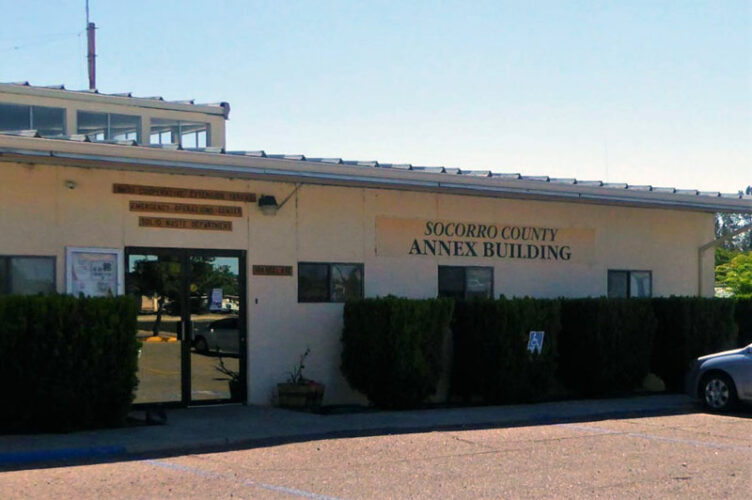
The Socorro County Commission meets in the County Annex building on Neel St. on the second and fourth Tuesdays each month.
This summer Socorro County agencies will be assisted by up to 30 young people, thanks to the approval by the county commissioners to allocate $62,680 toward the Summer Enrichment Internship Program. The internship program has received funding in the past, but the 2022 season is getting a substantial boost.
“Depending on how many interns we get, we can hire 30 interns at $12 an hour, 20 hours a week for six weeks,” County Manager Michael Hawkes said. “Last year it was 20 and I asked for an increase and PED agreed to it. And we also asked for an increase to $12 instead of the minimum wage of $11.50.”
The Summer Enrichment Internship Program was launched last year when the federal government committed more than $9.89 million for the program as part of pandemic relief efforts. Under the program, funding covers the cost of summer internships for New Mexico high school students, 16-19 years old. The goal is to “provide high school students and at-risk youth with the opportunity to participate in high-quality internships in government agencies, including county, tribal, and/or municipal placements.”
The summer internship program is through New Mexico Public Education Department.
“It’ll kick off in June,” Hawkes said. “We’ll have a few meetings before then with coordinators, and then students will start employment on June 6.”
Funding for program coordinators is also part of the package.
“Last year we had one coordinator for 10 interns,” he said. “This year it’s going to be one coordinator for 15. Usually, one is based in Socorro and one is based to handle the stuff in both Magdalena and Socorro.”
Hawkes said the interns last year were placed where they were needed, and where they could benefit from the experience.
“They were placed in county offices, the Forest Service, the Village of Magdalena,” he said. “Any government entity that’s wanting someone to come in and get some job experience and experience in the working environment.”
Those interested can stop by the county manager’s office at 210 Park Street for more information and an application.
In other actions, the commissioners approved the funding for the county extension office for extension educational programs for the fiscal year 2022-2023 beginning July 1.
In a letter submitted by extension agent Emily Bruton and NMSU Southwest Region Department Head Tom Dean, all extension educational programs in agriculture, consumer and environmental sciences, 4H and youth development, and community/economic development are funded by appropriations from county, state and federal governments.
Each level of government is requested to contribute a share of the total cost of the County Extension program.
The total estimated cost of operations for the Socorro County Extension office during FY 2022-2023 will be $191,983.92. The agency is requesting an increase in funding of $68,671.01.
“The increase is based on required funds to cover salaries and operations and maintenance. There was a legislative increase, which is reflected in this budget,” the letter stated. “The extension service is moving forward with programming efforts and excited to be working with youth face-to-face.”
The Socorro County Government has fully funded the annual county extension office request for many years.
The commission has also accepted a grant of over $300,000 to continue the Socorro County DWI Program. Athen Gassoumis heads up the program which not only handles DWI enforcement activities, but also provides DWI and Distracted Awareness and Education, public information activities aimed at the driving public, and other activities and programs aimed at reducing DWI related problems.
Overseeing the program is an eight-member Advisory Council that works toward educating and providing positive programming in Socorro County to combat DWI issues. The board is representative of the County’s ethnicity and continually reviews and follows the bylaws for the council ratified by the county commission. The chairperson is Craig Secatero, District 2 County Commissioner.
Also, on last week’s agenda was a discussion on the County Coalition to Assist Producers with Federal Wolf Compensation Funds. According to Hawkes, the commission indicated it would like to participate, but there are still one or two meetings before finalization.
“This has been going on for some time between New Mexico and Arizona,” Hawkes said. “A collaboration does exist between Socorro County and the counties on the western side to counties in Arizona. They said they would participate.”
A reintroduction program for the Mexican wolf by the U.S. Fish and Wildlife Service began in 1998 when the count of the endangered animals had dwindled to only 60 individual wolves. The population of Mexican gray wolves in Arizona and New Mexico grew by 10 animals last year, from 186 animals in 2020 to 196 in 2021.
Proponents of the recovery program say the pace of recovery is being hampered by illegal killings, disease and genetic mismanagement. Ranchers and others in rural communities that border wolf territory routinely cite livestock kills and safety concerns.



















